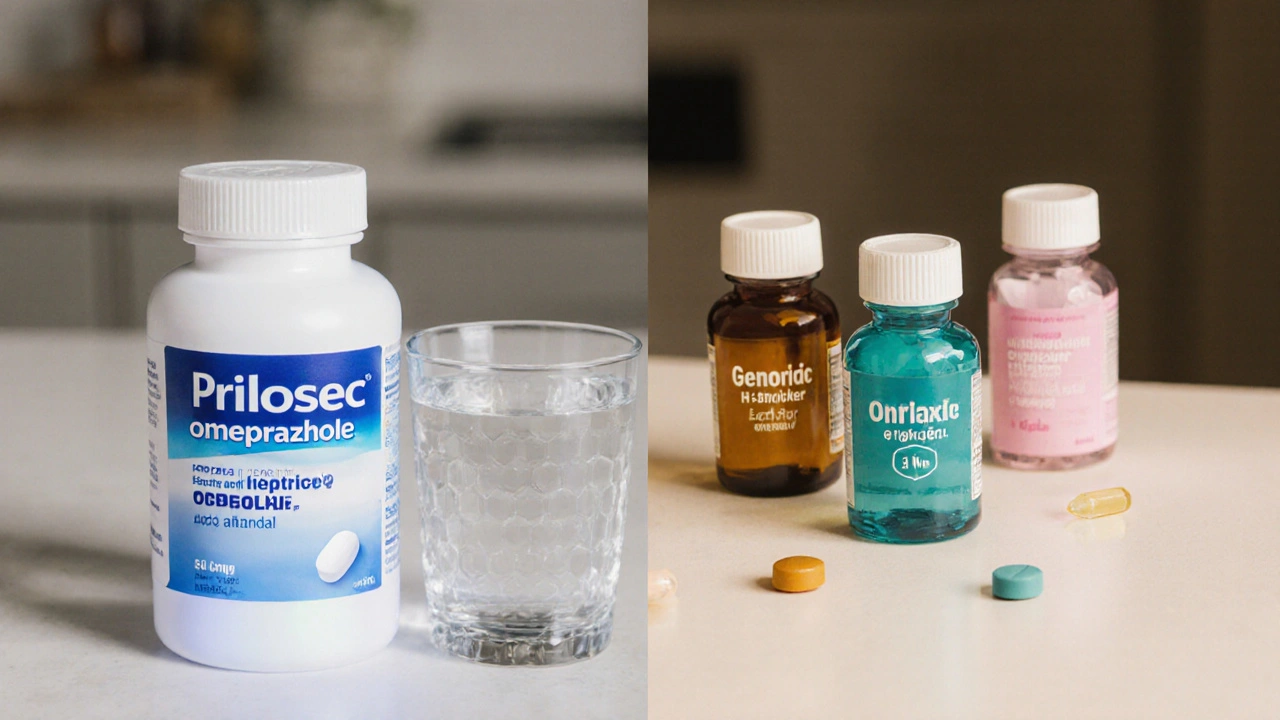Acid Reflux Medication Comparison Tool
Compare Acid Reflux Medications
Select your preferences below to see which medication might be best for you:
Quick Take
- Prilosec (omeprazole) is a proton‑pump inhibitor that’s been around since 1998 and is available OTC in 20‑mg packs.
- Newer PPIs like Nexium (esomeprazole) or Prevacid (lansoprazole) often cost more but may offer smoother symptom control for some people.
- H2‑blockers such as Zantac (ranitidine) work differently and are usually cheaper, but they don’t last as long.
- Key factors to compare: FDA approval year, dosing flexibility, OTC status, side‑effect profile, and price.
- Choose the drug that matches your symptom severity, insurance coverage, and tolerance for potential side effects.
When it comes to heartburn, indigestion, or GERD, the market is flooded with brand‑name pills, generics, and over‑the‑counter options. Prilosec vs alternatives is the question most shoppers ask after a night of tossing and turning. This guide walks you through the science, the pricing, and the real‑world pros and cons so you can stop guessing and start choosing.
What a Proton‑Pump Inhibitor Actually Does
A Proton Pump Inhibitor (a drug class that blocks the stomach’s acid‑producing pump) reduces the amount of acid your stomach releases. By shutting down the H⁺/K⁺‑ATPase enzyme, PPIs give irritated esophageal tissue a chance to heal and keep acid‑related symptoms at bay for up to 24hours.
Because they act at the source, PPIs are stronger than H2‑blockers, which only curb acid production indirectly. The trade‑off? Longer‑term use can affect calcium absorption, vitamin B12 levels, and even gut bacteria.
Prilosec (Omeprazole) - The Original PPI
Prilosec (Omeprazole) is a proton‑pump inhibitor approved by the FDA in 1998. It’s sold both as a prescription and, since 2003, as a 20‑mg OTC tablet.
- Typical dose: 20mg once daily before breakfast; higher doses (40mg) for severe GERD.
- Onset: 1-4hours, full effect after 2‑4days of consistent use.
- Common side effects: headache, nausea, abdominal pain, rare low‑magnesium levels.
- Price point: generic omeprazole costs about $0.20 per pill at most pharmacies.
Its long track‑record gives physicians confidence, but the drug’s half‑life is short, meaning the acid‑suppressing effect relies on the irreversible binding to pumps that regenerate over 24‑48hours.
Popular Alternatives on the Market
Here’s a quick snapshot of the most common competitors. Each belongs to the same PPI family except where noted.
- Nexium (Esomeprazole) - “the S‑isomer” of omeprazole, FDA‑approved in 2001. Often prescribed for erosive esophagitis.
- Prevacid (Lansoprazole) - FDA cleared in 1995, known for a slightly longer half‑life.
- Protonix (Pantoprazole) - FDA approved in 2000; used often in hospital IV form.
- Zantac (Ranitidine) - an H2‑blocker that works upstream of PPIs. Pulled from U.S. shelves in 2020 due to NDMA contamination concerns, but still referenced for historical comparison.

How to Compare: Decision Criteria That Matter
Not all comparisons are created equal. Below are the five criteria that most influence a patient’s choice.
- Regulatory status: Prescription vs OTC affects insurance coverage and out‑of‑pocket cost.
- Onset and duration: Faster relief may matter for occasional heartburn; longer coverage benefits chronic GERD.
- Side‑effect risk: Bone‑health concerns, kidney issues, or drug‑drug interactions vary among PPIs.
- Price & insurance: Brand‑name PPIs can be 5‑10× the price of generic omeprazole.
- Formulation options: Capsules, tablets, delayed‑release, or IV forms give flexibility for surgery or severe cases.
Side‑by‑Side Comparison Table
| Generic Name | Brand Name | FDA Approval Year | OTC Availability | Typical Dose | Key Advantage | Common Side Effects |
|---|---|---|---|---|---|---|
| Omeprazole | Prilosec | 1998 | Yes (20mg) | 20mg daily | Lowest cost, long‑standing safety data | Headache, nausea, low magnesium |
| Esomeprazole | Nexium | 2001 | No (prescription‑only) | 20‑40mg daily | May offer smoother acid control | Diarrhea, abdominal pain, rare liver issues |
| Lansoprazole | Prevacid | 1995 | Yes (15mg) | 15‑30mg daily | Longer half‑life, good for nocturnal symptoms | Headache, constipation, rash |
| Pantoprazole | Protonix | 2000 | No (prescription‑only) | 40mg daily | IV formulation for hospital use | Nausea, flatulence, rare C.difficle infection |
| Ranitidine | Zantac | 1983 | Was OTC (removed 2020) | 150mg twice daily | Works faster for mild heartburn | Headache, dizziness, potential NDMA exposure |
Best‑Fit Scenarios: Who Should Pick Which Drug?
- Budget‑conscious occasional heartburn: Prilosec OTC or generic omeprazole - cheap and effective for short bursts.
- Chronic GERD with night‑time symptoms: Prevacid 15mg or Nexium 20mg - longer coverage may reduce nighttime reflux.
- Post‑surgery or severe ulcer requiring IV therapy: Protonix IV - delivers immediate acid suppression.
- Patients wary of long‑term PPI risks: Try an H2‑blocker like famotidine (not listed) for mild cases, but discuss with a doctor.
Safety Tips and Long‑Term Considerations
All PPIs share a handful of warnings. Use the lowest effective dose for the shortest time needed. If you’ve been on a PPI for more than 8‑12weeks, schedule a review with your physician to assess bone density, magnesium levels, and possible need for a step‑down strategy.
Drug‑drug interactions are common with clopidogrel, certain HIV meds, and some antifungals. Always hand your pharmacist a complete medication list.
How to Switch Safely
- Talk to your doctor about why you want to change - symptom patterns, cost, or side effects.
- Ask if a taper is needed; abrupt stops can cause rebound acid hypersecretion.
- Pick the new drug based on the comparison table above.
- Start the new medication at the recommended dose and monitor symptoms for 1‑2 weeks.
- If symptoms return, keep a symptom diary and bring it to your next appointment.

Frequently Asked Questions
Can I take Prilosec and Nexium together?
No. Both are PPIs, so combining them offers no extra benefit and increases the risk of side effects. If one isn’t working, switch under a doctor’s guidance.
Is over‑the‑counter Prilosec as effective as prescription‑strength?
For mild‑to‑moderate heartburn, the 20‑mg OTC dose works well. Severe GERD often needs higher prescription doses or a different PPI.
What are the long‑term risks of taking PPIs?
Extended use can lower magnesium and calcium absorption, raise fracture risk, and increase susceptibility to certain infections like C.difficle. Periodic labs help catch issues early.
Should I switch to an H2‑blocker if I’m worried about PPI side effects?
Possibly, but H2‑blockers don’t stay effective as long and may need multiple daily doses. Discuss symptom severity with your provider before changing.
How quickly will I feel relief after starting a PPI?
Most people notice symptom reduction within a few hours, but full ulcer healing can take 4‑8weeks of consistent use.
Choosing the right acid‑reflux pill is a mix of cost, convenience, and how your body reacts. Use the table, weigh the criteria, and bring any concerns to your healthcare provider. With the right match, you’ll keep the burn at bay without breaking the bank.


barry conpoes
September 29, 2025 AT 02:40When you peruse the cornucopia of acid‑reflux therapeutics, it becomes evident that the market is awash with mediocrity, yet a select few ascend to true pharmacological eminence. Prilosec, the archetype of PPIs, boasts a legacy that eclipses its flashy successors. Its generic status translates to an unparalleled cost‑to‑benefit ratio, a fact that any discerning American consumer should cherish. Moreover, the FDA‑approved moniker carries a gravitas that the newer brands merely aspire to emulate. In short, when patriotism meets prudence, the original PPI wins hands down.
Kristen Holcomb
October 7, 2025 AT 19:00Hey folks, just wanted to chime in with a bit of a warm welcome! If you're new to the whole reflux stuff, don't feel overwhelmed-there's a lot to learn but the basics are simple. Think about your budget, how often you get heartburn, and how long you need the meds. Starting with a low‑dose OTC Prilosec can be a gentle intro before you consider a prescription. Also, keep an eye on any side effects; everybody reacts a little differently. Hope this helps you feel more confident in picking the right option!
justin davis
October 16, 2025 AT 11:20Wow!!! Another generic pill that does the same thing as the pricey brand!!!! Who needs a PhD to know that?
David Lance Saxon Jr.
October 25, 2025 AT 03:40In the grand tapestry of gastrointestinal pharmacotherapy, one must pivot beyond mere price‑point analysis and engage in a heuristic synthesis of pharmacokinetic constellations, receptor affinities, and the ontological implications of acid suppression on systemic homeostasis. The prototypical proton‑pump inhibitor, omeprazole, operates as an irreversible inhibitor of the gastric H+/K+ ATPase enzymatic complex, effecting a cascade that attenuates gastric acidity for up to 24 hours. Its biotransformation via CYP2C19 and CYP3A4 pathways introduces a degree of interindividual variability that mandates genotype‑guided dosing in certain cohorts, particularly those with polymorphic expression of hepatic enzymes. Conversely, esomeprazole, the S‑enantiomer of omeprazole, offers an ostensibly marginally enhanced bioavailability, positing a theoretical superiority in acid‐control kinetics, albeit at a cost premium that may not be clinically justified for most patients.
Equally salient is the nuanced differential in half‑life extension observed with lansoprazole, which confers a modest nocturnal acid‑suppression advantage, rendering it a plausible candidate for refractory night‑time heartburn. The pharmaceutical landscape further diversifies with pantoprazole, whose distinct chemical scaffold permits intravenous delivery-a salient factor in acute care settings where rapid acid suppression is paramount.
Yet, the discourse must not be myopically anchored to pharmacodynamics; long‑term sequelae of chronic PPI therapy invoke a cascade of physiological perturbations, including hypomagnesemia, diminished calcium absorption, and an altered microbiome milieu that predisposes to Clostridioides difficile infection. The risk calculus, therefore, should integrate patient‐specific comorbidities, such as osteoporosis propensity, renal insufficiency, and potential drug–drug interactions-particularly with clopidogrel, where PPI‐mediated CYP2C19 inhibition can attenuate antiplatelet efficacy.
From a health‑economics perspective, the generic omeprazole paradigm presents an optimal balance between therapeutic potency and fiscal responsibility, especially within the framework of insurance formularies that prioritize cost containment without compromising clinical outcomes. Nevertheless, the prescriber must remain vigilant to the emergent data delineating potential cardiovascular and renal implications of protracted PPI exposure, thereby navigating an evidence‑based, patient‑centred therapeutic algorithm.
In summation, the decision matrix for acid‑reflux management transcends simplistic brand versus generic dichotomies, demanding a multidimensional appraisal encompassing pharmacogenomics, safety profiling, dosing convenience, and socioeconomic factors. Only through such a holistic lens can clinicians orchestrate a regimen that optimally aligns with individual patient narratives and the broader imperatives of prudent pharmacotherapy.
Moore Lauren
November 2, 2025 AT 19:00Great summary.
Sally Murray
November 11, 2025 AT 11:20From an epistemological standpoint, the comparative analysis presented herein underscores the importance of contextualizing drug selection within the broader framework of patient‐centric care. The author’s systematic breakdown of cost, efficacy, and safety aligns with best practices in evidence‑based medicine. Moreover, the inclusion of a decision‑making tool exemplifies an applied methodology that can be readily adapted by clinicians and laypersons alike. Such clarity fosters informed consent and shared decision‑making, which are foundational to therapeutic success.
Bridgett Hart
November 20, 2025 AT 03:40The long‑term risks are often downplayed in promotional material but they deserve attention; chronic use may lead to deficiencies and infections. Patients should be encouraged to reassess therapy regularly with their physician and consider step‑down strategies where appropriate. Vigilance in monitoring labs can preempt serious complications.
Sean Lee
November 28, 2025 AT 20:00Analyzing the pharmacodynamic profile of omeprazole reveals a high degree of receptor occupancy, which translates into sustained acid suppression across the gastric mucosa. This mechanistic insight is pivotal when juxtaposing it against H2‑blockers, whose transient effect may be insufficient for nocturnal reflux management.
Michael Christian
December 7, 2025 AT 12:20Just wanted to say that it's great to see a balanced view. If you’re on a budget, the OTC option is solid, but if symptoms are severe, talking to a doc about stronger meds is a good move.
Steven Elliott
December 16, 2025 AT 04:40Sure, all PPIs work the same, but the marketing hype makes people think the new ones are magic.
Lawrence D. Law
December 24, 2025 AT 21:00Attention to detail: the article mistakenly refers to "C.difficle" instead of "C. difficile". Accuracy matters, especially in medical writing.